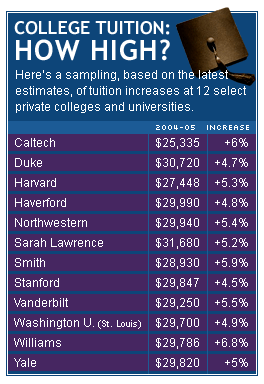NEW YORK (CNN/Money) – As one academic year draws to a close, Quadrangle Jane can bank on this: Another, more expensive one looms on the horizon.
That's right. The cost of going to college in September will, as it has since the 1980s, rise far more than inflation.

CNN/Money took the temperature of the tuition gods at 15 well-regarded schools across the country. Tuition hikes ranged from 4.5 percent at Stanford to 11.1 percent for out-of-state students at the University of Washington at Seattle.
Most schools on our list are estimating tuition increases of between roughly 5 percent and 6 percent. And those increases only account for the costs of attending classes, not room, board and other living expenses.
Given that inflation has been running at around 2.3 percent on annualized basis, it seems like college tuition is the Secretariat of the consumer cost race – always ahead by several lengths.
But in some ways that may not be the fairest comparison.
"We don't buy consumer products to provide an education. We buy a ... set of goods different than what the Consumer Price Index references," said Ted Bracken, director of federal relations for the Consortium for Financing a Higher Education (COFHE).
Bracken likens the costs of providing a college education to running an opera house. You could try cutting the orchestra in half, or do away with the costumes and sets. "But that's not what the customer wants," he said.
Okay, but why are prices so high?
Even if you agree with that reasoning, you still may wonder why the sticker price for college is so high – and getting higher every year.
There are several reasons. Here are just a few:

Labor costs: Compensating Prof. Publish-or-Perish isn't just about salary. It's about the cost of productivity and healthcare.
Educating students can be labor intensive, particularly when a school boasts a low student-to-teacher ratio. Given that set up, it's hard to make labor more productive, since a college would have to churn out a significantly higher number of students year after year, said Sandy Baum, coauthor of the College Board report, "Trends in College Pricing 2003."
As for healthcare, she noted, "If we could get healthcare costs under control, that would make a big difference."
Student aid: The average share of the sticker price families can pay has decreased both because the student population now includes more students from lower-income households than ever and also because family incomes for all but the very rich haven't kept pace with tuition costs in recent years, Baum said.
| RELATED ARTICLES
|

|
|
|
|
As a result, "one of the most rapidly growing components of the budget is student aid," she said.
And one of the ways to fund greater aid payouts besides tapping alumni giving and school endowments is to raise tuition.
Prestige U: In research for his book "Tuition Rising: Why Colleges Cost So Much," Cornell economics professor Ronald G. Ehrenberg found several forces at work that resulted in higher tuition costs – some of which are tied to a school's desire to be perceived as among the best.
From state-of-the-art facilities and technology to providing resources for cutting-edge research (genomics, anyone?), there's a pressure to surpass the Joneses to attract the best students. And that costs money.
Cost cutting at private colleges is also difficult if it means the president or provost would lose the support of a large portion of his or her faculty, since without their support it becomes very tough to run the school, Ehrenberg argues.
And as ironic as it sounds, alumni giving (and the pride alumni take in what their alma mater does well) can play a role, too.
Like faculty, Ehrenberg wrote, "They also have strong preferences about what should be valued and, by strongly communicating these preferences and threatening to withhold contributions, they discourage institutions from cutting almost anything."
Who really pays full fare?
Even though sticker prices for a college education keep going up, that doesn't mean every student and parent are on the hook for full fare.
In 2002-03, nearly half of all undergraduates received some grant aid – money that never needs to be repaid. And about 60 percent of undergrads received financial aid in some form, including grants, loans and work study, according to the College Board.
Or consider the aid statistics from COFHE, which counts among its 31 member schools some of the most elite and expensive schools in the country, many of which are on CNN/Money's list.
In 2002-03, when the total cost of attending a COFHE school – including room, board and other expenses – averaged $37,940, 49 percent of students received need-based grant money. The average award: $18,161.
-- CNN/Money staff writer Deshundra Jefferson helped compile tuition costs for this article.

|

